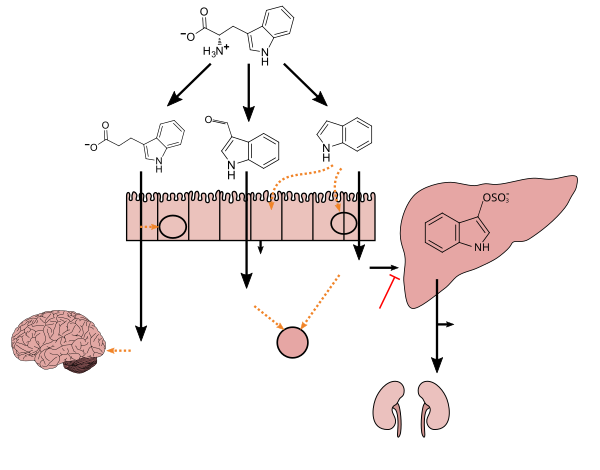Indoxyl sulfate

| |
| Names | |
|---|---|
|
Preferred IUPAC name
1H-Indol-3-yl hydrogen sulfate | |
| Other names
3-Indoxylsulfate; 3-Indoxylsulfuric acid; Indol-3-yl sulfate
| |
| Identifiers | |
|
|
|
3D model (JSmol)
|
|
| ChEBI | |
| ChEMBL | |
| ChemSpider | |
| DrugBank | |
|
PubChem CID
|
|
| UNII | |
|
CompTox Dashboard (EPA)
|
|
| |
| |
| Properties | |
| C8H7NO4S | |
| Molar mass | 213.21 g·mol−1 |
|
Except where otherwise noted, data are given for materials in their standard state (at 25 °C [77 °F], 100 kPa).
| |
Indoxyl sulfate, also known as 3-indoxylsulfate and 3-indoxylsulfuric acid, is a metabolite of dietary L-tryptophan that acts as a cardiotoxin and uremic toxin. High concentrations of indoxyl sulfate in blood plasma are known to be associated with the development and progression of chronic kidney disease and vascular disease in humans. As a uremic toxin, it stimulates glomerular sclerosis and renal interstitial fibrosis.
Biosynthesis
Indoxyl sulfate is a metabolite of dietary L-tryptophan that is synthesized through the following metabolic pathway:
Indole is produced from L-tryptophan in the human intestine via tryptophanase-expressing gastrointestinal bacteria. Indoxyl is produced from indole via enzyme-mediated hydroxylation in the liver;in vitro experiments with rat and human liver microsomes suggest that the CYP450 enzyme CYP2E1 hydroxylates indole into indoxyl. Subsequently, indoxyl is converted into indoxyl sulfate by sulfotransferase enzymes in the liver; based upon in vitro experiments with recombinant human sulfotransferases, SULT1A1 appears to be the primary sulfotransferase enzyme involved in the conversion of indoxyl into indoxyl sulfate.
|
Tryptophan metabolism by human gastrointestinal microbiota (
)
Tryptophanase-
expressing bacteria Intestinal
immune cells Neuroprotectant:
↓Activation of glial cells and astrocytes ↓4-Hydroxy-2-nonenal levels ↓DNA damage –Antioxidant –Inhibits β-amyloid fibril formation Maintains mucosal reactivity:
↑IL-22 production Associated with vascular disease:
↑Oxidative stress ↑Smooth muscle cell proliferation ↑Aortic wall thickness and calcification Associated with chronic kidney disease:
↑Renal dysfunction –Uremic toxin |
Clinical significance
Occasionally in urinary tract infections, bacteria produce indoxyl phosphatase which splits indoxyl sulfate forming indigo and indirubin creating dramatic purple urine. Indoxyl sulfate is also a product of indole metabolism, which is produced from tryptophan by intestinal flora, such as Escherichia coli.

